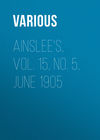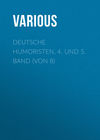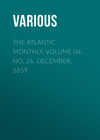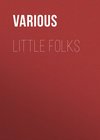Читать книгу: «Birds and All Nature, Vol. V, No. 4, April 1899», страница 4
THE HOARY BAT
C. C. M
A VERY singular animal is the bat, and seems to belong to several classes and orders. The specimen we present here (Atalapha cinerea) is very rare in this part of the country, and was taken in Lincoln Park, Chicago. It flies through the air like a bird and, possessing mammæ like the quadrupeds, suckles its young. The double jaw is provided with three kinds of teeth. With the canines and incisors it tears its prey like carnivorous animals, and with the molars or grinders it cracks nuts like rodents, which it resembles in the narrow, oval form of its head. An imperfect quadruped when on the ground, it drags itself along, embarrassed by the mantle of its wings, which fold up around its legs like an umbrella when closed. When it undertakes to fly it does so in an awkward manner. It first crawls painfully along, and with great difficulty extends its long fingers, spreading out the membrane which covers and binds them together. The ungainly creature then quickly flaps its broad wings, tough as leather, but thin and transparent; a bird without plumage, it now flies abroad in pursuit of insects – nocturnal like itself – or in search of ripe fruit, to which some species are particularly destructive.
None of the bats like to raise themselves into the air from a perfectly level surface, and, therefore, use all their endeavors to climb to some elevated spot, from whence they may launch themselves into the air. They climb with great ease and rapidity, being able to hitch their sharp and curved claws into the least roughness that may present itself, and can thus ascend a perpendicular wall with perfect ease and security. In so doing they crawl backward, raising their bodies against the tree or wall which they desire to scale, and drawing themselves up by the alternate use of the hinder feet. When they have attained a moderate height, they are able to fling themselves easily into the air and to take immediate flight. They have the power of rising at once from the ground, but always prefer to let themselves fall from some elevated spot. One reason why bats take their repose suspended by their hind feet is said to be that they are then in the most favorable position for taking to the air. There may be, and probably are, other reasons for the curious reversed attitude. Even among the birds examples are found of a similar mode of repose. Members of the genus Colius, an African group of birds, sleep suspended like the bats, clinging with their feet and hanging with their heads downward. But these birds cannot assume this attitude for the purpose of taking flight, as their wings are used as readily as those of most other feathered creatures, and, therefore, there must be other reasons to account for the strange attitude.
The more closely we approach the torrid zone, it is said, the greater is the number of bats and the richer their variety. The South is the native country of the majority of wing-handed animals. Even in Italy, Greece, and Spain, the number of bats is surprising. There, according to Brehm, who studied them industriously, as evening draws nigh they come out of their nooks and corners not by hundreds but by thousands. Out of every house, every old stone wall, every rocky hollow they flutter, as if a great army were preparing for a parade, and the entire horizon is literally filled with them. The swarms of bats one sees in a hot country are astonishing. They darken the sky. Everywhere there is a living and moving mass flying through the trees or gardens and groves. Through the streets of the town, through houses and rooms flits the moving train. Hundreds are constantly appearing and disappearing and one is always surrounded by a hovering swarm.
A feature of the wings of bats, is a highly elastic skin. The outer layer is constantly kept pliable by anointing with an oily liquid, secreted by glands in the animal's face. The structure of the hair is also remarkable, as each thread presents under the microscope a screw-like appearance.
THE COMING OF SPRING
E. E. BENTON
NO ONE perhaps ever lived who excelled Henry D. Thoreau as a general observer of nature. He patiently and with minute care examined both animate and inanimate creation, and wrote down an accurate account of his observations, noting particularly the effects produced by the changes in the seasons. He worked diligently to discover the first sign of spring, with results not wholly satisfactory. In one place he asks: "What is the earliest sign of spring? The motions of worms and insects? The flow of sap in trees and the swelling of buds? Do not the insects awake with the flow of the sap? Bluebirds, etc., probably do not come till the insects come out. Or are there earlier signs in the water, the tortoises, frogs, etc.?"
He found that whenever there was a warm spell during the winter some forms of vegetation, particularly the grasses and water plants, would begin to grow, and some would even bloom in favorable locations, as the skunk cabbage. He did not fully settle the question as to what would begin to grow first in the spring, whether it was the catkins of the swamp willow or the stems and leaves of the equisetum in the pool, or something else.
A list of the most striking phenomena observed by Thoreau in early spring is given below, and is extracted from his journals, written when he lived near Boston, during the years 1840 to 1860. In each case the earliest date mentioned by Thoreau is given, there being a difference of about a month between the earliest and latest spring. Many of these phenomena and the order in which they occur are common to a large extent of country, including the eastern and northern central states. Thus, the skunk cabbage is the first flower in all this region. A few notes are added, showing variations.
February 21 – Sap of the red maple flowing. This was in 1857. It does not usually flow until the second week in March.
February 23 – Yellow-spotted tortoise seen.
February 24 – The bluebird, "angel of the spring," arrives; also the song-sparrow. The phebe or spring note of the chickadee, a winter bird, heard.
"The bluebird and song-sparrow sing immediately on their arrival, and hence deserve to enjoy some preëminence. They give expression to the joy which the season inspires, but the robin and blackbird only peep and tchuck at first, commonly, and the lark is silent and flitting. The bluebird at once fills the air with his sweet warbling, and the song-sparrow, from the top of a rail, pours forth his most joyous strain."
March 1 – The catkins of the willow and aspen appear to have started to grow.
March 2 – The caltha, or cowslip, found growing in water.
The skunk cabbage in bloom in warm, moist grounds.
March 5 – The red maple and elm buds expanded.
The spring note of the nut-hatch heard: To-what, what, what, what, what, rapidly repeated, instead of the usual quah quah of this winter bird.
March 6 – The gyrinus (water-bug) seen in the brook.
First blackbird seen.
Green sprouts of the sassafras, hazel, blueberry, and swamp-pink found.
March 7 – Fuzzy gnats in the air.
First robins.
Spring note of the shrike heard, probably silent during the winter.
March 8 – Willow buds expanded. Sap flowing in the white pine.
Flock of grackles seen.
Radical leaves of the golden-rods and asters in water, growing decidedly.
March 9 – Ducks seen.
March 10 – Poplar and willow catkins started; also equisetum (horse-tail), saxifrage, and probably other water plants. The butter-cup found growing.
Shimmering in the air noticed, caused by evaporation; water in the brooks, "clear, placid, and silvery," both phenomena of spring.
March 12 – Poplar catkins in bloom.
First meadow-lark seen.
March 14 – Wild geese seen.
Fox-colored sparrows seen.
March 15 – Grass growing in water.
Wood, or croaking frog heard; "the earliest voice of the liquid pools."
March 16 – The first phebe bird heard. Gulls and sheldrakes seen.
March 17 – Grass green on south bank-sides.
The first flicker and red-wing seen; also a striped squirrel; also some kind of fly.
March 18 – The skunk cabbage, in moist grounds, abundantly in bloom, attracting the first honey-bees, who, directed by a wonderful instinct, leave their homes and wing their way, perhaps for miles, to find this first flower. This seems all the more remarkable when it is considered that the honey-bee is an introduced, not a native insect.
March 19 – The first shiners seen in the brook.
March 20 – Pussy-willow catkins in full bloom.
"The tree-sparrow is perhaps the sweetest and most melodious warbler at present."
"The fishes are going up the brooks as they open."
March 21 – The garden chickweed in bloom.
The ground-squirrel's first chirrup heard, a sure sign, according to some old worthies, of decided spring weather.
The hyla, or tree-frog, begins to peep.
"The woods are comparatively silent. Not yet the woodland birds, except (perhaps the woodpecker, so far as it migrates) only the orchard and river birds have arrived."
March 23 – The white maple in bloom and the aspen nearly so; the alders are generally in full bloom. "The crimson-starred flowers of the hazel begin to peep out."
March 24 – Shore-larks seen.
March 28 – Buff-edged butterflies seen.
March 31 – The small red butterfly seen.
April 5 – Swallows appear, pewee heard, and snipe seen.
April 6 – Cowslips nearly in bloom.
April 7 – Gold-finches seen; also the purple finch.
April 8 – Pine warbler seen.
The epigæa (trailing arbutus) nearly in bloom. "The earliest peculiarly woodland, 2 herbaceous flowers are epigæa, anemone, thalictrum (or meadow rue), and, by the first of May, the violet."
April 9 – Cowslips 3 (not a woodland flower) in bloom, "the first conspicuous herbaceous flower, for that of the skunk cabbage is concealed in its spathe."
THE NASHVILLE WARBLER
(Helminthophila rubricapilla.)
LYNDS JONES
THE Nashville warbler is common during the migrations in many parts of the country, but seems to be scarce or entirely wanting locally. Thus, in Lorain county, Ohio, as well as in Poweshiek county, Iowa, it is always one of the commonest warblers during the first and second weeks of May, and again during the second and third weeks of September, while it is not reported from Wayne county, Ohio, by Mr. Harry C. Oberholser in his "List of the Birds of Wayne county, Ohio." There are other instances of its rarity or absence from restricted localities. Its range extends from the Atlantic ocean west to eastern Nebraska, and north into Labrador and the fur countries, occasionally wandering even to Greenland. It winters in the tropics south of the United States.
In the northward migration it reaches Texas about the third week in April and Manitoba near the end of the first week in May, thus passing completely across the country in about three weeks. A careful computation proves that the average rate at which this warbler traveled across the country, in the spring of 1885, was nearly forty miles a day. A single year, however, might show a considerable departure from the normal rate of migration. This instance is given to show any who may not be familiar with the phenomena of bird migration that small birds, at least, do not perform their whole migration in a single flight, but rest a good deal by the way.
The migrating Nashville warblers, in my experience, prefer the outskirts of the larger woods, but may be found anywhere in the smaller woods, preferring the middle branches, rarely ascending to the tree-tops, not seldom gleaning near the ground in the underbrush, or even among the leaves on the ground. They are by no means confined to the woods, but glean as boldly and sing as cheerfully among the fruit and shade trees in town, but they are more numerous in the woods.
The song has been compared to that of the chestnut-sided warbler and the chipping sparrow combined. To my ear the Nashville warbler's song is enough unlike the song of any other bird to be easily recognized after a single hearing. Rev. J. H. Langille's rendering: "Ke tsee, ke tsee, ke tsee, chip ee, chip ee, chip ee, chip," is a close approximation, but seems somewhat lacking in the true expression of the first part of the song. My note book renders it thus: "K tsip, k tsip, k tsip, k tsip, chip ee, chip ee, chip ee, chip." The first part of the song is thus halting, with a considerable pause between the phrases, while the last part is uttered more rapidly and with little effort. This song, issuing from the trees in every direction, is always closely associated in the writer's mind with the early morning hours, the dripping trees and the sweet incense of the flower-decked woods and bursting buds.
While feeding, these warblers often gather into groups of a dozen or twenty individuals, and may be associated with other species, thus forming a considerable company. The warbler student is familiar with the waves of warblers and other small birds which range through the woods, now appearing in a bewildering flutter of a hundred wings, now disappearing in their eager quest for a lunch of insects.
The breeding-range of this warbler extends as far south as Connecticut in the East, and Michigan and Minnesota, if not northern Iowa in the West, and north to the limit of its range. In common with the other members of this genus, the Nashville warbler nests on the ground, usually in a spot well protected by dried grasses and other litter of the previous year's growth, often in a tangle of shrubs, ferns and bushes. The nest is sometimes sunk flush with the surface, and is composed of grasses, mosses, pine needles, strips of bark and leaves, lined with finer material of the same sort and with hair-like rootlets, the composition varying with the locality. The eggs are pure white or creamy-white, marked with spots and dots of reddish-brown and the usual lilac shell-markings, which are grouped more or less around the larger end. They are four or five in number, and average about .61 × .48 of an inch.
The spring males may readily be recognized in the bush by their small size, by the bright yellow underparts, by their ashy heads and back, and by their habit of feeding in the middle branches of the trees down to the underbrush. The concealed rufous spot on the crown, from which the bird takes its scientific specific name, can rarely be seen in the live bird, no doubt chiefly because the bird is perpetually above you.
The skunk cabbage, which is not a woodland flower, and therefore not included in the above list, is the first flower probably in all New England and the northern states.





















